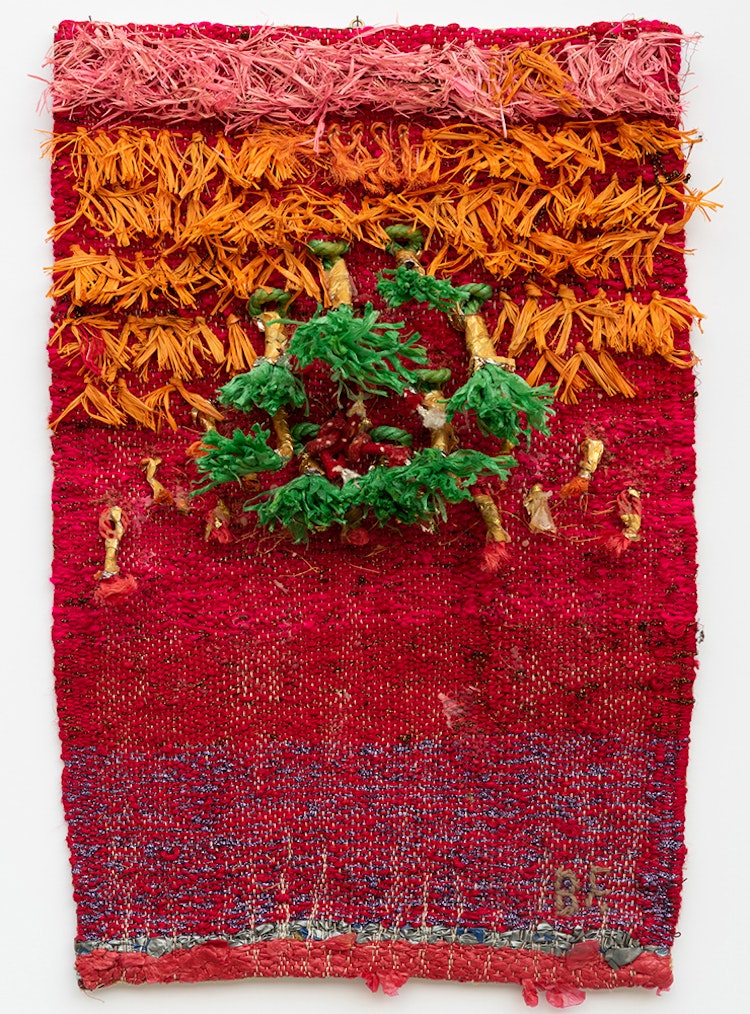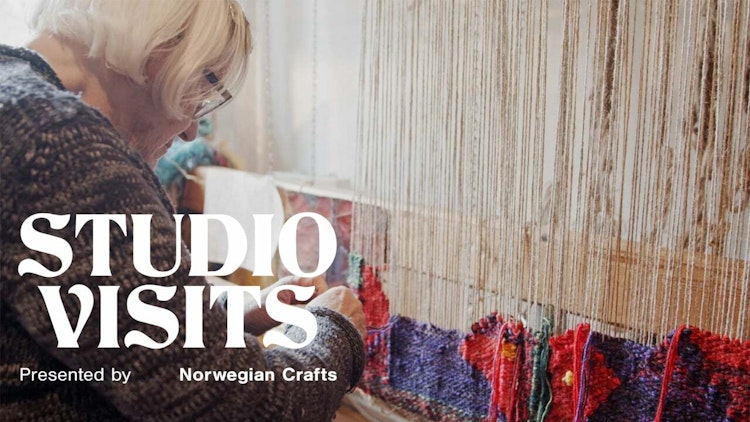Zoe Black
Kjersti Solbakken
by Norwegian Crafts and Revers Produksjon
Zoe Black is the community development curator at the gallery Objectspace in Auckland Aotearoa New Zealand.1 During a visit to Norway in February 2020, while curator in residence with Norwegian Crafts, Black had the chance to pay a visit to the home of one of the foremost textile artists in Norway, Brit Fuglevaag. The following article contains responses from Fuglevaag that Black got from her visit and from a recording of a studio visit conducted by Kjersti Solbakken, director of Kunstnerforbundet.
Visiting Brit Fuglevaag’s residence in Oslo is like entering a warm, humming cocoon. Every surface is laden with tapestries that reflect her continuous creative output, and the walls vibrate with the energy she imbues in each of her weavings. Decades of work, collections of objects, paintings by family and posters advertising past exhibitions around the world overwhelm each space but collectively reflect the tenacity of an artist with relentless purpose and momentum to create.
Brit Fuglevaag has been at the forefront of Norway’s textile art scene since the 1970s. After spending four years at the National College of Art and Craft (Statens håndverks- og kunstindustriskole, SHKS) from 1959, she was awarded a Polish state scholarship and spent just over a year at the Academy of Fine Arts in Warsaw. This was a pivotal time in her life, not only meeting her husband, Polish painter Ryszard Warsinski, but because she was able to see how textile artists were valued in Poland the same way as painters and sculptors.
'Poland was an example of how tapestry and painting were considered the same, on the same level. Norway wasn’t as contemporary in this thinking yet, but I knew in my head they were on the same level. There were all these men in Norway who would do cartoons and the women would weave them, it was far away from the art that was happening in Europe. Some of them would say that that was not art.'
On returning to Norway, with her new understanding of how textile art could be, she began working experimentally with different types of materials and gained notice from other textile artists.
'In the beginning, Norway’s older generation of textile artists were helping me, sending me to international biennales, exhibitions abroad, things like this. They liked what I was doing because there wasn’t anyone else doing it, so they helped me. This was how I came to Paris for the first time, for a youth biennale in Paris with my tapestries.'


Woollen works are very time consuming; they demand a lot of focus; I work on them until I get tired and then I switch rooms and start playing a bit with different materials. I don’t plan when I make my experimental works, I just start to weave, and it comes like this.
International exposure helped Fuglevaag confirm her belief in how textile making should be seen within a contemporary art context. She actively pursued these intentions through political advocacy in the 1960s and 70s, alongside teaching and becoming the first professor of textile at SHKS. Her firm views on the importance of seeing textiles in the same way as other mediums helped set a trajectory for textile art in Norway that has ensured it has become an enduring tradition within the canon and for Fuglevaag to be considered a major figure within this tradition.
She has always held an outward view of her practice, understanding how it fits broadly into the creative ecosystem. Partly, this understanding has come from a sustained mobility through her life. She has continuously kept residencies in different parts of Europe, taking inspiration from a rural property in Italy, her atelier in Paris and summer house along the Varangerfjord in Finnmark. Each place adding layers of connection to other artists and contributing creatively to what and how she makes, the changing landscapes giving her valuable impulses that trigger new directions in her practice.
Now, back in Oslo, Fuglevaag reminisces romantically about the studios she has found herself creating in but is happy to have settled in Norway for the past ten years, although she travels between her townhouse and summer home east of Vadsø. It seems these two locations – the city and the beach at Varangerfjord – very much echo the two distinct directions her practice has taken now. The city, reflected in the more traditional weavings she produces using wool and featuring compositions that abstractly reference flora and fauna, and the beach, shown through the wild and strong shapes in her more experimental works, woven using unconventional materials and bold colours.
Although Fuglevaag is an octogenarian, she is constantly working, developing ideas, and producing new works for exhibitions. There is a loom in almost every room of her Oslo house with tapestries at various stages of completion. She purposefully sectioned out her work into the different spaces – woollen weaving in two rooms and the living room, her found material pieces created in a separate annex. She likes moving between her different ways of working, taking time to focus on what she can do with wool then getting up and switching her thoughts to create with alternate materials.
'Traditional work goes very slowly, I look at the materials and think of the colours and the ideas and take some colours from here and there and then make. Woollen works are very time consuming; they demand a lot of focus; I work on them until I get tired and then I switch rooms and start playing a bit with different materials. I don’t plan when I make my experimental works, I just start to weave, and it comes like this.'
Her woollen tapestries are what she displays most in galleries now, she says the critics don’t pay much attention to her experimental compositions, although these are the ones that draw me in when visiting her home. The luscious quality she is able to conjure from recycled and found materials contribute to an intrigue that is impossible to overlook. They are harder and more sculptural but equally as luminous and have a freshness to them, although some are twenty or thirty years old.
In her earlier years she would scout for materials in Paris. When wool was too expensive, she collected what she could from local shops. A breakthrough happened when a fashion house on the same street as her atelier was throwing away their paper pattern off-cuts. She gathered up as much of the delicate tissue as she could and started experimenting with a technique for weaving with the paper, soaking the stock and massaging bits together to form a fabric that would stiffen when dry. This variation on papier-mâché has become a process she has used many times. She now uses newspapers and subtly dyes them in delicate shades of pink and blue. She says, ‘anything is weavable’ and this philosophy has continued in her experimental works, ignoring the traditional notions of fibre to communicate a vision that sees materials and process as possibilities, rather than limitations.
Each summer when Brit is staying at her holiday home she walks along the shore of the nearby fjord and collects discarded fibres. Found rope, sisal, fishing line and any other fabric is systematically collected and strung together. These bundles are then hung outside her cottage and left for the winter. The elements naturally knead the fibre and give each piece an indistinguishable texture that comes from slow organic processing.
'I hang them on the house, so they are hanging the whole winter, and then it’s raining and snowing and cold and warm, and they are washed. And then I come back, and they are ready for me and maybe the sun has taken the colour down and others are very blue or very green or very orange. So, then I take them down and into the house and I start to weave.
They give me the inspiration. I can’t get any of these materials in the shops, here there are different types of threads and colours. We also have Russian fishermen so there are materials from Russia and from Norway and things we don’t see normally.'


These works are wild and playful and show an industrious confidence with how one should approach working with fibre. Fuglevaag is also conscious of the environmental reference she is making through using recycled materials and while it is not her entire motivation, there is an inherent ecological underpinning to these works.
'The audience is able to start thinking about the materials and what they mean to be used in this way. But it is both. Seeing the materials on the beach reminds me of tapestries, so I take them and clean the beach and I also find some interesting materials.'
She approaches materials with certainty, she is able to manipulate the chosen fibre with a delicate but knowing hand. She describes herself as stubborn, but this assuredness has meant she has consistently pushed her work forward, creating in ways that are unexpected and don’t play to global trends.
There are stacks of catalogues dotted around her rooms and they give just a hint of her achievements. She recounts some of the international shows she has taken part in and laments the demise of key textile focused events that once existed on Europe’s art calendar. However, she is content with how the scene is now.
'There are some very good younger artists working in textile in Norway now. They are more liberated and more free. I like seeing what they are doing and it encourages me to think differently. They treat textiles like painting, I cannot do it just like them but I can go a bit nearer to what they are doing.'
While she is happy working independently, it is obvious that she needs her work to be seen, that the dialogue around textile art and how it is valued is very important to her. When visiting she was deliberating three exhibitions simultaneously, with each gallery floor plan being carefully considered. She would be a formidable artist to work with as a curator and she chuckles at the suggestion of planning collaboratively with a gallery. She knows her work so intimately and she knows the best way to display it.
Fuglevaag is a practitioner who personifies the idea of a maker and the impetus she has for creating is unceasing. The way she has consistently pushed textile art to be considered as something more, both for others and with her own work, ensures she will continue to be central in contemporary textile discussions. Her weavings are not objects that can sit passively on a wall – they speak of creativity, of innovation, liberation, artistic expression and ultimately of a progressive point of view of an artist in every essence of the word.
